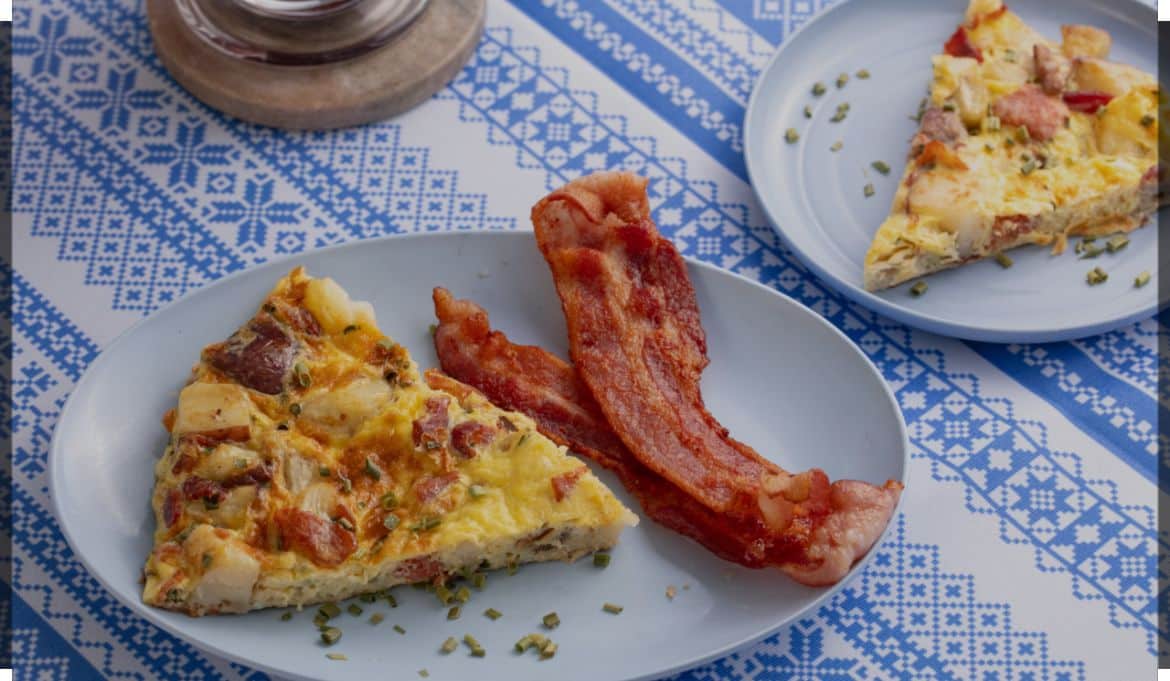Discover the Delightful Danish Dish: Æggekage (Danish Egg Cake)
Looking for a taste of traditional Danish cuisine? Look no further than Æggekage, a savory dish that translates to egg cake in English. This simple yet satisfying recipe is a staple in Denmark and is loved by locals and visitors alike.
Æggekage is made with eggs, milk, flour, and various toppings such as bacon, onions, and herbs. The result is a fluffy and flavorful egg-based dish that can be enjoyed for breakfast, lunch, or dinner.
This versatile dish is perfect for any occasion – whether you’re hosting a cozy brunch with friends or looking for a quick and delicious meal on a busy weeknight. Serve it hot out of the oven with a side of fresh greens or crispy potatoes for an authentic taste of Denmark.
So why not try your hand at making this classic Danish food at home? With just a few simple ingredients and some basic cooking skills, you can enjoy the comforting flavors of Æggekage whenever the craving strikes.
Æggekage (Danish Egg Cake) Recipe
Ingredients:
- 6 eggs
- 1 cup milk
- 1/2 cup all-purpose flour
- Salt and pepper to taste
- 1 tablespoon butter
- Optional toppings: bacon, ham, cheese, herbs
Preparation time: 10 minutes
Cooking time: 20 minutes
Serves: 4 persons
This traditional Danish dish is a simple yet delicious meal that can be enjoyed for breakfast, brunch, or even dinner.
Instructions:
- In a mixing bowl, whisk together the eggs and milk until well combined.
- Sift in the flour and continue to whisk until there are no lumps.
- Add salt and pepper to taste.
- Preheat a skillet over medium heat and melt the butter.
- Pour the egg mixture into the skillet and let it cook undisturbed for a few minutes until the edges start to set.
- If using any toppings such as bacon or ham, sprinkle them over the egg mixture at this point.
- Carefully lift the edges of the egg cake with a spatula to allow any uncooked egg to flow underneath.
- Cook for another 5-7 minutes or until the bottom is golden brown.
- If using cheese, sprinkle it over the top of the egg cake and place under a broiler for a minute or two until melted.
- Serve hot with fresh herbs if desired. Enjoy your homemade Æggekage!
Difficulty score: 3 out of 10
The difficulty level for this recipe is relatively low as it only involves basic cooking techniques such as whisking eggs and cooking on a skillet. The key is to ensure that the egg cake is cooked evenly without burning while adding your favorite toppings for extra flavor!
Nutrition: Æggekage (Danish Egg Cake)
As a chef specializing in Danish cuisine, I have created a list of nutrition per serving for the traditional Danish recipe, Æggekage (Danish Egg Cake).
- Calories: 250
- Protein: 15g
- Fat: 18g
- Carbohydrates: 5g
- Fiber: 1g
This dish is relatively healthy as it is high in protein and moderate in calories. The eggs provide a good source of protein while the minimal carbohydrates make it suitable for those following low-carb diets. However, the dish is also moderately high in fat, so it should be eaten in moderation as part of a balanced diet.
Overall, Æggekage is a delicious and satisfying Danish food that can be enjoyed as a breakfast or brunch option.
Serving suggestions for Æggekage (Danish Egg Cake)
If you are looking to serve your Danish Egg Cake in a traditional Danish way, consider topping it with some fresh herbs like parsley or dill. You can also add a dollop of sour cream or crème fraîche on top for added richness and flavor.
To complement the savory flavors of the Æggekage, you can also serve it with a side salad made with fresh greens, tomatoes, cucumbers, and a light vinaigrette dressing. The freshness of the salad will balance out the richness of the egg cake.
- Fresh herbs: parsley, dill
- Dairy: sour cream, crème fraîche
- Side salad: mixed greens, tomatoes, cucumbers
- Dressing: vinaigrette
What to serve with Æggekage (Danish Egg Cake)
In addition to the traditional toppings and side salad mentioned above, you can also serve your Danish Egg Cake with some sliced rye bread and butter. The hearty rye bread will pair well with the rich and custardy texture of the egg cake.
If you want to make your meal more substantial, consider serving some cured meats, such as different variations of sausages or bacon on the side. The salty and savory flavors of the cured meats will complement the flavors of the egg cake.
- Bread: rye bread, butter
- Cured meats: sausages, bacon
- Sides: pickles, mustard
- Beverage: Danish beer or aquavit
Enhancing the Flavor of Æggekage (Danish Egg Cake)
If you want to take your Æggekage (Danish Egg Cake) to the next level and increase its flavor, I recommend adding some fresh herbs such as dill or chives. These herbs will not only add a pop of color to your dish but also bring a refreshing and aromatic flavor that complements the eggs perfectly.
You can also consider incorporating some smoked salmon or crispy bacon into your Æggekage. The smoky and salty flavors from these ingredients will add an extra layer of complexity to the dish, making it even more delicious.
For a touch of sweetness, try caramelizing some onions before adding them to the egg mixture. The caramelized onions will add a rich and slightly sweet flavor that pairs beautifully with the savory eggs.
Spicy Score: 1 out of 10
Reason: Traditional Danish cuisine is not known for its spiciness, so it’s best to keep the heat level low when preparing Æggekage. Instead, focus on enhancing the natural flavors of the ingredients with herbs, smoked meats, and caramelized onions for a delicious and balanced dish.

